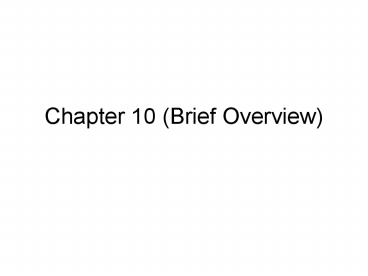Chapter 10 Brief Overview - PowerPoint PPT Presentation
Title:
Chapter 10 Brief Overview
Description:
The life history is the schedule of an organism's life, including: age at maturity ... Red-headed manakin. Lack's Proposal. Lack made 3 key points: ... – PowerPoint PPT presentation
Number of Views:54
Avg rating:3.0/5.0
Title: Chapter 10 Brief Overview
1
Chapter 10 (Brief Overview)
2
But first, review
Joseph Grinnell
- Resource Utilization Curve
- How is it related to the niche?
- Niche discussion
- How is it related to acclimation?
- Not a constant set of environmental conditions
- Questions about this stuff?
Charles Elton
GE Hutchinson
3
What is life history?
- The life history is the schedule of an organisms
life, including - age at maturity
- number of reproductive events
- allocation of energy to reproduction
- number and size of offspring
- life span
4
Compare
- Elephant
- Life span 50y
- Age at 1st reproduction 13-20yrs
- Gestation 21-22m
- young 1
- Parental care
- ? - none
- ? - herd consists of matriarch, male and female
offspring until 12y, then male offspring leave
herd, female offspring stay.
- Salmon
- Life span 1-8y
- Age at 1st reproduction
- 1-8y
- Gestation how long it takes to swim from ocean
to spawning grounds - young (eggs)
- 2500 - 7000
- Parental care
- ? - none
- ? - none
5
Survivorship curves
6
What influences life histories?
- Life histories are influenced by
- body plan and life style of the organism
- evolutionary responses to many factors,
including - physical conditions
- food supply
- predators
- other biotic factors, such as competition
7
A Classic Study
- David Lack of Oxford University first placed life
histories in an evolutionary context - tropical songbirds lay fewer eggs per clutch than
temperate counterparts - Lack speculated that this difference was based on
different abilities to find food for the chicks - Temperate breeders have longer days in which to
find food than tropical breeders
Snow bunting
Red-headed manakin
8
Lacks Proposal
- Lack made 3 key points
- because life history traits (i.e. of
eggs/clutch) contribute to reproductive success
they influence evolutionary fitness - life histories vary in a consistent way with
respect to factors in the environment (reaction
norms) - hypotheses about life histories are subject to
experimental tests - Therefore Life history is shaped by natural
selection and are amenable to scientific method
9
An Experimental Test
- Lack
- Artificially increase of eggs/clutch.
- There would be no reduction in success.
- Therefore, the number of offspring is limited by
food supply - This proposal has been tested repeatedly
- Gören Hogstedt (1980) manipulated clutch size of
European magpies - maximum number of chicks fledged corresponded to
normal clutch size of seven
10
- Hogstedt (1980) Magpies (Pica pica)
- Perrins and Moss (1975) Great tits (Parus major)
Expected w/ No resource limitations
Predicted by Lack Observed
11
Components of Fitness
- Generic offspring in next and future gens.
- Genetic proportion of alleles in next and future
gens. - Fitness, ultimately dependent on producing
successful offspring - Components
- maturity (age at first reproduction)
- parity (number of reproductive episodes)
- fecundity (number of offspring per reproductive
episode) - aging (total length of life)
12
Life Histories A Case of Trade-Offs
- Organisms face a problem of allocation of scarce
resources (time, energy, materials) - the trade-off resources used for one function
cannot be used for another function - Remember
- Altering resource allocation affects fitness.
- Consider the possibility that an oak tree might
somehow produce more seed - how does this change affect survival of
seedlings? - how does this change affect survival of the
adult? - how does this change affect future reproduction?
13
Concept of renewal
Now P Year 1 P(1r) Year 2 P(1r)2 Year 3
P(1r)3
Choices
Self survival? Parental care?
How often do I breed?
Few large? Many small?
How fast growth and maturity?
14
Life histories resolve conflicting demands.
- Life histories represent trade-offs among
competing functions - a typical trade-off involves the competing
demands of adult survival and allocation of
resources to reproduction - kestrels with artificially reduced or enlarged
broods exhibited enhanced or diminished adult
survival, respectively - Hence parental cost.
15
The life table






























